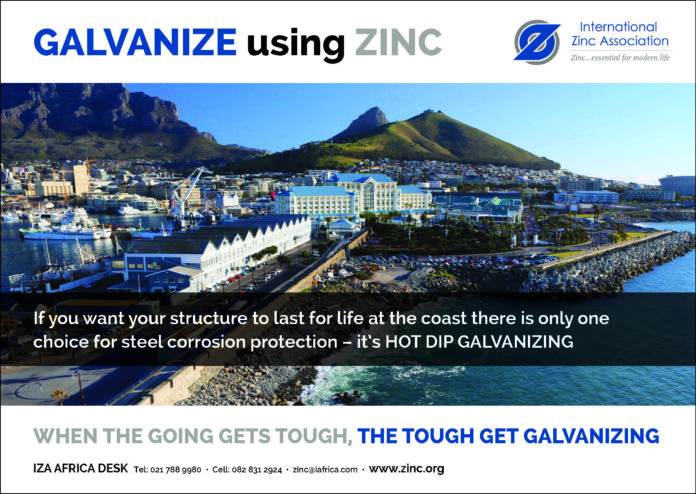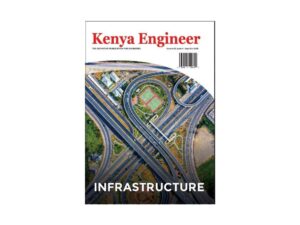Last Updated 1 month ago by Kenya Engineer
Steel remains the backbone of modern infrastructure worldwide, yet its susceptibility to corrosion poses a significant threat to safety, durability, and sustainability. From rail networks and power pylons to bridges, marine structures, and transport hubs, corrosion is a costly challenge, particularly in humid, coastal, and industrial environments.
According to Simon Norton, Director of the International Zinc Association (IZA) Africa), zinc offers the most effective and reliable solution.
“Steel’s vulnerability to corrosion is a significant challenge, especially in environments with high humidity, sea salt, and variable air temperatures,” says Norton. “Zinc provides an exceptional and indispensable form of protection, ensuring the durability and safety of infrastructure for decades.”
How Zinc Protects Steel
Zinc’s unique effectiveness lies in its dual protective action. When applied as a coating, zinc forms a physical barrier between steel and corrosive environments. More importantly, because zinc is more electrochemically active, it acts as a sacrificial anode, corroding in preference to the steel substrate.
“Even when a zinc coating is scratched or damaged, the exposed steel remains protected by zinc’s sacrificial behaviour,” explains Norton. “This property sets zinc apart from all other corrosion protection methods.”
Hot-Dip Galvanizing: A Proven Solution
The most widely used method is hot-dip galvanizing, where steel is immersed in molten zinc. This process forms a metallurgical bond that creates multiple alloy layers, harder than the base steel itself. The result is exceptional durability, abrasion resistance, and decades-long performance even under the harshest conditions.
Across the globe, rail networks, marine facilities, and transport infrastructure are among the most vulnerable assets due to constant exposure to salt-laden air, humidity, and pollutants. Chloride ions accelerate rusting of steel tracks, fasteners, signalling equipment, and bridges — a problem faced in coastal cities from New York to Mumbai, Sydney to Lagos.
“Failure of these components can result in derailments, service disruptions, and prohibitive maintenance costs,” Norton notes. “Hot-dip galvanized coatings on rail fasteners, signalling poles, overhead line structures, and bridge elements ensure that these critical assets withstand relentless environmental challenges.”
Power Infrastructure and Zinc Protection
Power transmission pylons, which form the backbone of electrical grids worldwide, are continuously exposed to harsh weather and industrial pollutants. In coastal and industrial regions, the corrosion risk is particularly severe.
“Galvanized coatings are the first line of defence for pylons,” says Norton. “The self-sacrificing galvanic protection of zinc ensures that even minor abrasions or surface cuts do not compromise structural integrity. This protection is essential in preventing failures that could trigger widespread power outages.”
Zinc in Buildings and Urban Infrastructure
Exposed steel in buildings, pedestrian bridges, airports, and transport hubs faces equally serious challenges. Without adequate protection, corrosion reduces load-bearing capacity and compromises structural safety.
“Hot-dip galvanizing of beams, columns, and fasteners provides exceptional durability in all environments — from fog-bound coastal cities to humid tropical regions,” says Norton. “It minimises the need for repainting or maintenance and delivers substantial whole-life cost savings.”
Reinforcing Concrete with Zinc
It is often assumed that concrete inherently protects embedded steel, but chloride penetration from sea spray and carbonation of the concrete matrix can initiate corrosion. Once corrosion begins, expanding rebar causes cracking and spalling of the concrete.
“Galvanized rebar is critical for infrastructure in marine and chloride-rich environments,” Norton emphasises. “The zinc coating delays the onset of corrosion, and once initiated, zinc sacrifices itself to protect the steel. This dramatically extends the service life of bridges, parking garages, and marine structures.”
Building Sustainable Infrastructure for the Future
Zinc coatings are not optional extras — they are fundamental to resilient and sustainable infrastructure.
“By extending the service life of steel, zinc reduces maintenance, improves safety, and ensures reliability across critical infrastructure systems,” concludes Norton. “For countries worldwide, the adoption of hot-dip galvanized steel and galvanized rebar is essential to building infrastructure that endures for generations.”

























